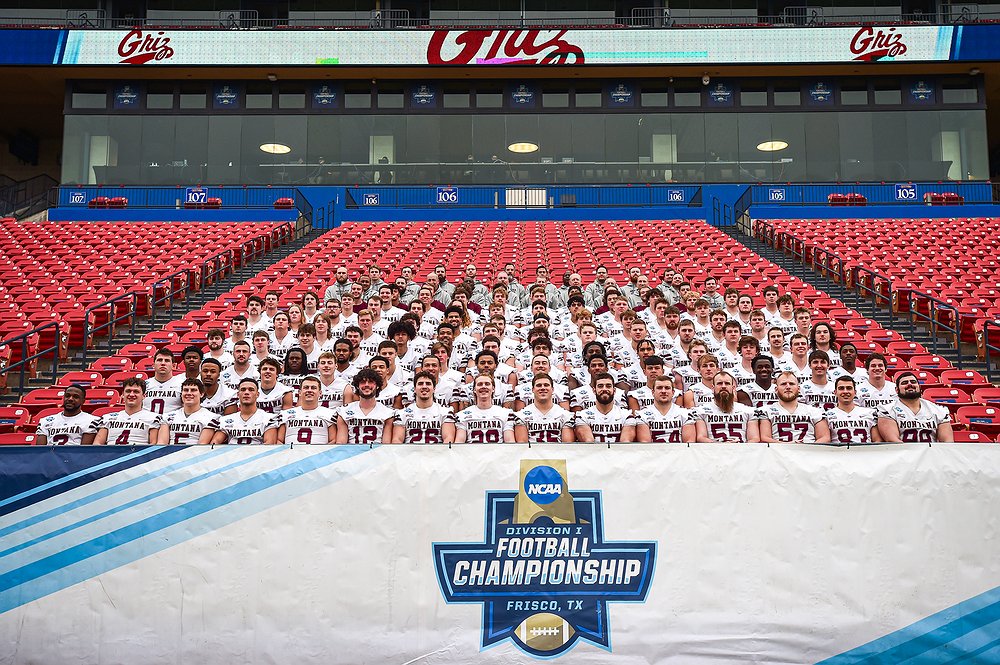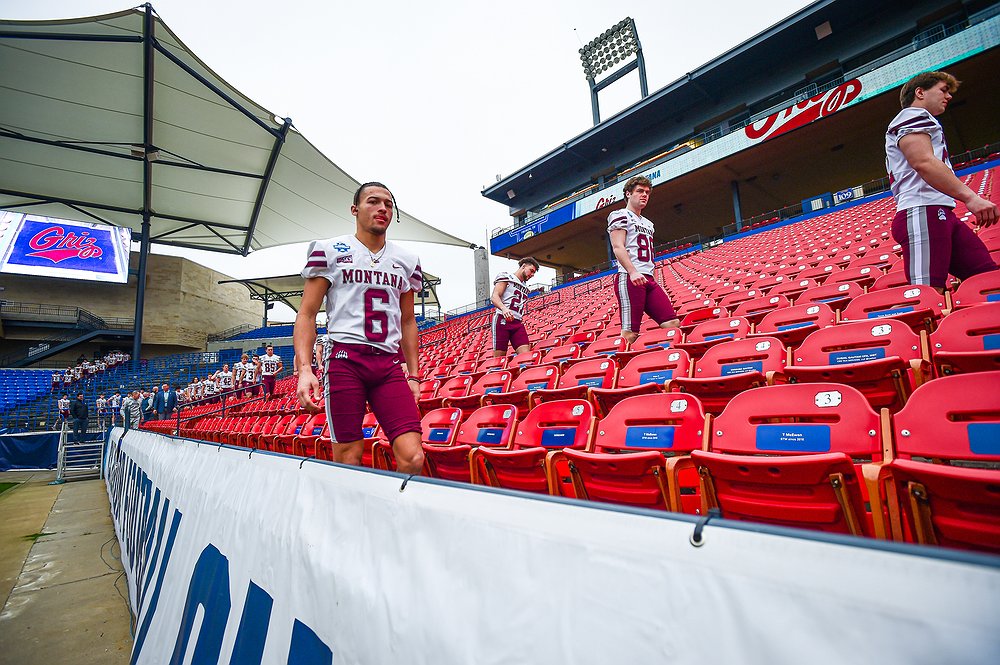Something will have to give when Jacks, Griz battle again
FRISCO, Texas — South Dakota State plays Montana for the NCAA Division I Football Championship Sunday, and something has to give.
For Montana coach Bobby Hauck, it’s a string of three losses in these games: His Griz lost in the final in 2004, 2008 and ‘09.
Meanwhile the defending champion Jackrabbits are looking for their first-ever win over Montana. Incredibly, given their recent success — 12 straight playoff appearances, 28 straight wins — they are 0-8 against the Silvertips.
One loss sticks out for first-year SDSU head coach Jimmy Rogers: A 61-48 loss at Missoula in what was his program’s first FCS-level playoff game. The Jacks led it 48-21.
“Oh, it sticks with me,” Rogers, a linebacker on that SDSU squad, said Friday. “That was the last game I ever played. Montana was my first Division I game I played (a 7-0 loss in 2005), and we went back there four years later, from a freshman to a senior, and we should have won that football game, and we lost it.
“I think you can learn something from every loss that you have. To say one means more than the other when they end your season and you care enough, they matter. If you don't learn from them, you waste the opportunity to absorb a lot of information and a lot of ways in which you could have handled it better to have success. That moment, I'll never forget honestly.”
South Dakota State is a heavy betting favorite, with a point spread of 10.5-11.5 points.
“As I mentioned when I first sat down, the team on the other side is always good,” Hauck said. “As simple as it may sound, both teams are good football teams. You have to play well to win the game. If you don't play well, there's no way you're going to win it. So you have to go play well and get a couple of breaks, and that's the way it goes. The team we're playing has won 28 straight. They're awfully good.”
Read Remembered
For portions of Friday press availability for Hauck and UM athletic director Kent Haslam, the subject turned to Don Read.
Read, who died Wednesday at the age of 90, wore both hats at UM, coaching the Grizzly football team for 10 years, culminating in their first national championship in 1995, and then returning as AD on May 28, 2004 and staying for 14 months.
“Washington-Grizzly Stadium was built in 1986 and Don Read gave everyone a reason to fill it up,” Haslam, who just completed his 11th year as Montana’s AD, said. “Don Read was the anchor of that and really we are the beneficiaries of his investment and passion in the Montana Grizzlies.”
Hauck cut his teeth in college football as a graduate assistant on Read’s staff in 1988.
“Coach Read passed pretty much while we were in the air coming down here,” Hauck said. “Coach Read had an unbelievable impact on a lot of people, just a truly great man and a great guy. He got me going in coaching, along with several guys on our staff.
“Just a wonderful human being. I think that for him to be as beloved by the percentage of his former players that he is is just phenomenal and speaks volumes to who he is.”
Asked about Read’s list of yearly goals, Hauck corrected a reporter who remembered one being to win one game a year via special teams play.
“Two games a year,” Hauck said. “It is in our special teams book. I’ve plagiarized a bunch from Don over the years.
Read guided Montana’s special teams during his decade as coach (1986-95) and Hauck has done the same in his Griz tenure, and has seen Junior Bergen return one kickoff and two punts for scores in Montana’s last two games, both wins, both in overtime.
This special teams path wasn’t ordained by Read, though..
“I always kind of avoided it when I was around Coach Read just because I didn't — I wasn't interested in it,” he said. “Then when I went to UCLA, Coach (Terry) Donahue roped me in, and that's where I kind of got going on it. I used to run the other direction when Coach Read would come. I should have listened. My attitude about it put me three years behind, or two.
“Coach emphasized it obviously. It was his thing. I think I always took it from Coach that he really truly believed it was a third of the game.”
Linebacker U
There are similarities between these two proud programs. For example, the Jackrabbits have 28 South Dakota natives on the roster, and 17 show up on their two-deep.
For Montana the numbers are 46 on the roster and 14 on the depth chart.
One difference: SDSU’s linebacker depth contains not one native son, while Montana’s goes 5-for-6. It continues a trend in which UM’s second line of defense are blue-collar players who often join the program without a scholarship.
Exhibits A and B are top tackler Braxton Hill (Anaconda) and Tyler Flink (Missoula Big Sky), who both walked on.
“I feel at least as long as I’ve been here and going back to watching when I was a kid, the linebackers are primarily Montana kids,” said Levi Janacaro (Big Sky), who has been attending Griz games with Flink, his best friend, since both were eighth-graders. “Just Montana kids that love the University of Montana and love what it means to be a Griz. I feel like we’re not maybe the most athletic dudes, but we will outwork almost anybody.
“I feel like that’s kind of a Montana guy thing. Not to knock the linebackers who aren’t from Montana, because Riley Wilson has been fantastic.”
Wilson, a native of nearby Prosper, Texas, transferred in from Hawaii. On Thursday his family hosted the entire Griz roster for a barbecue.
Rostad is Elite
Junior Carson Rostad, another of those Montana linebackers on the two-deep, was announced as a winner of Elite 90 Award at the end of the Grizzlies’ team picture session Friday.
The awards go to the player with the highest cumulative GPA that’s participating in an NCAA championship. He graduated Summa Cum Laude this fall in finance with a 3.91 GPA, and has been accepted into the university’s MBA graduate program.
Twin Threats
Jaxon Janke is 15 minutes younger than Jadon Janke, and at birth was one pound heavier.
“Maybe that extra 15 minutes in the womb helped me out,” he said Friday.
The two receivers, who have 99 combined catches this season, were walk-ons as well. Excellent basketball players in Madison, S.D. — a town of 6,000 45 miles from SDSU’s campus in Brookings — they waited for scholarship offers to roll in. They trickled in at best.
“So basketball coaches were holding off because they thought we wanted to play football,” Jaden Janke said. “Football coaches held off because of basketball. We did not help ourselves at all. No camps; ‘Our film’s good enough.’ ”
It was Jaxon Janke that made the decision that football was the choice, and Jaden committed a week later. Turned out they were only walk-ons for about a week.
Then-coach John Steigelmeier found them some scholarship money.
“Which we ironically had to share the first couple of years,” Jaxon Janke said.
But the point is clear. Home grown talent is important. Like sophomore Tucker Large from Sioux Falls, a walk-on.
“He was definitely undervalued,” Jaxon Janke said. “A lot of people doubted him because of his size, but as you can see this year, he’s grown into a heck of a player. The best punt returner in the nation.”
















